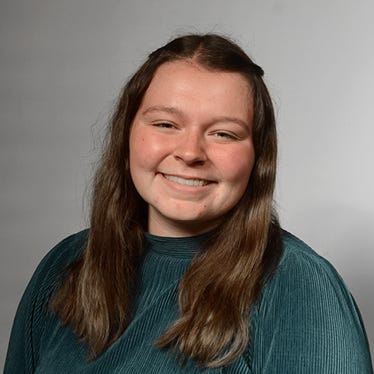
ENJOY THE VIEW: Kenny Cain reflects on the work his family has poured into conserving the natural resources on their farm. “Even I have no problem catching fish in this pond,” he quips.
SEE FIRSTHAND: The pond offers a look at the effects of conservation efforts for visitors to Cain’s Homelike Farms. The students who attend the Fourth Grade Field Days stop here for one of the stations.
MAKING SENSE: At the water cycle station during the Fourth Grade Field Days, students receive colored beads depending on their location as a water droplet: blue ocean, brown soil, green plant, white glacier, etc. They then get to wear these beads as a bracelet.
TOUCH, FEEL, SEE: Cain’s goal for the Fourth Grade Field Days is for students to have a chance to touch, feel and see the effects of conservation.
AHA MOMENT: Cain says showing fourth grade students a real beaver dam helps them realize that wildlife is present in this environment. Here, Cain observes a dam in the creek.
HEALTHY SIGNS: Cain points at a bass spawning bed visible from the surface of the pond. These signs show him the pond ecosystem is thriving.
MILESTONE: Last summer, Cain’s Homelike Farms celebrated its 25th year of hosting Fourth Grade Field Days. Pictured are Kenny and Marlene Cain (left) and Terry and Amy Cain.
MANY THANKS: Cain is grateful for the help and guidance he has received from local organizations, agronomists and mentors over the years as he has continued on his conservation journey.
MANY THANKS: Cain is grateful for the help and guidance he has received from local organizations, agronomists and mentors over the years as he has continued on his conservation journey.
Improved soil health, wildlife habitats and watersheds do not happen overnight. These environments and their results take decades of conservation efforts to achieve. Kenny Cain, Darlington, Ind., has reached that point.
Cain was recognized as the 2023 Conservation Farmer of the Year by the Indiana Association of Soil and Water Conservation Districts. He operates Cain’s Homelike Farms with his brother Terry, his son Josh, and his nephews Zach, Seth and Jess. The farm, which Cain’s parents purchased as a dairy in 1951, was not always conservation oriented.
“It was a poster child for what not to do — cow paths becoming gullies, manure finding its way to the creek,” Cain says. He adds that he watched his parents work hard to clean up the farm and mentor their growing family about the importance of stewardship and community.
Cain embraced that guidance and knew he wanted to reverse the erosion from traditional farming practices while improving soil fertility and crop productivity. He started this journey by installing two grass waterways in 1973.
Perfecting conservation practices
Those first two waterways kicked the door open to Cain’s conservation efforts. He quickly dove headfirst into no-till, cover crops, riparian buffers, filter strips, and wildlife and pollinator habitats. Whenever he read about a new practice or got more information from his local SWCD, he found a way to test it.
“We’re adopters, and we adopted these practices from mentors,” Cain says.
He soon noticed that the conservation efforts lent themselves to more profitability and savings in the operation. Cain notes that they were able to use less fuel, sequester more nutrients, improve soil fertility and control soil erosion.
“The economics piece of soil conservation needs to be amplified,” Cain says. But what’s larger than the economics factor, and the main reason why Cain keeps conservation top of mind, is the wildlife and environment component.
Being a good steward
“The wildlife is a big piece of me,” Cain adds. “I just can’t get enough of it.”
Cain recalls growing up with fencerows, woods and abundant wildlife habitat. However, he saw those features fade. His goal has been to bring them back even stronger.
“With growing up on a farm and seeing the wildlife, and then losing the wildlife after clearing fencerows, I wanted to replace that habitat,” Cain explains. “It was almost like a guilt complex, where you had it and then it was gone.”
A line that has stuck with him as he has worked to rebuild that habitat comes from a famous Joni Mitchell song lyric: “Don’t it always seem to go, you don’t know what you’ve got ‘til it’s gone.”
Aside from implementing conservation efforts on his farm to rebuild wildlife habitats, Cain has been involved in a variety of organizations that promote the same message, including the Montgomery County SWCD, State Soil Conservation Board, Sugar Creek Advisory Board, Conservation Cropping Systems Initiative steering committee, local Indiana Department of Environmental Management steering committee and Darlington Conservation Club. He and Terry even helped found the Coal Creek chapter of Pheasants Forever, dedicated to preserving pheasants, quail and other wildlife.
Thanks to mentors
Cain says his success with conservation and recognition as Conservation Farmer of the Year, sponsored by Indiana Farm Bureau, would not be possible without the help of mentors and local organizations and agencies. He recalls David Swaim, their agronomist at the time, providing some of his first conservation guidance and forming the No-Tillers Roundtable, a network of farmers meeting to share ideas.
Cain says the Montgomery County SWCD, Indiana State Department of Agriculture, Department of Natural Resources, Purdue University, Farm Service Agency and Natural Resources Conservation Service are all to thank for his conservation efforts. They’ve connected him with the right programs to fit his operation and goals. He is also thankful for his current agronomist, Aaron Gault with Advanced Agrilytics. Additionally, he says there was always a copy of Indiana Prairie Farmer on the kitchen table that would often provide new ideas.
“We’ve relied on mentorship,” Cain says. “In turn, we try to help mentor others.”
Paying it forward with mentorship has come in many forms for Cain. He has hosted a variety of field days and workshops for visitors to see for themselves how his conservation efforts work in the operation. There have been various training events at his farm for SWCD, ISDA and NRCS folks to experience those conservation efforts firsthand. Ultimately, Cain is happy with his operation being an example for others looking to start their conservation journey.
“We educate — it’s part of what we do,” Cain adds. “That’s my platform. It’s my association with our local soil and water conservation district to bring the programs to educate.”
Conservation education starts with kids
Aa large chunk of Cain’s education efforts is directed at the next generation of farmers and conservationists.
This year will mark the 26th Fourth Grade Field Days at Cain’s Homelike Farms. There are 425 students from three school districts, as well as some homeschool students, that attend this event. It spans several days and highlights the importance of conservation.
North Montgomery and South Montgomery FFA members, staff from NRCS and the Indiana State Department of Agriculture, SWCD board members, and Purdue Extension folks all help teach at the event. The idea for this hands-on event spawned when Cain was considering where to start with conservation education.
“Part of our mission is to educate, and educating seasoned farmers can sometimes be a challenge,” Cain explains. “So, we came up with the idea to get them while they’re young.”
Students have the chance to rotate through eight stations across two locations at the farm. The stations cover the following topics:
the water cycle
forestry
wildlife
prairie
water quality
wetlands
erosion
insects
Cain says the erosion control demonstration table is always a highlight.
“We have hands-on stuff, where they can touch and feel and see,” he adds.
He says they try to focus on the basics of conservation so the students can understand why it is important to protect wildlife, soil and water. Cain feels satisfied knowing that the students leave with a better grasp on conservation.
“It’s a highlight of our year,” Cain says. “I hope they leave with an appreciation for conservation.”
About the Author(s)
You May Also Like



.jpg?width=700&auto=webp&quality=80&disable=upscale)


